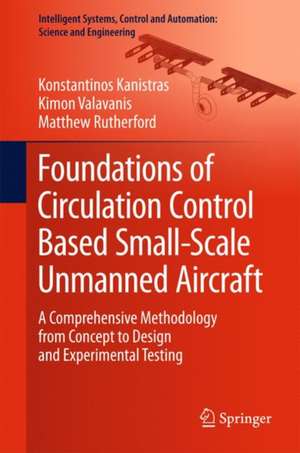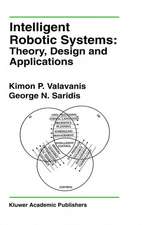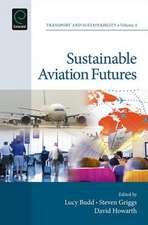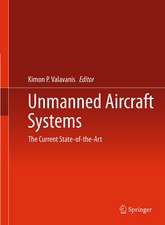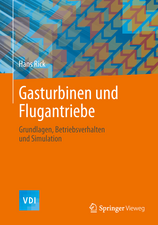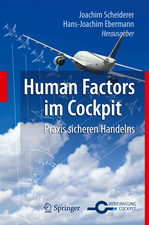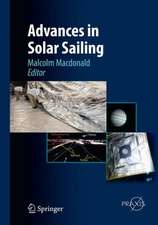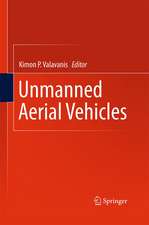Foundations of Circulation Control Based Small-Scale Unmanned Aircraft: A Comprehensive Methodology from Concept to Design and Experimental Testing: Intelligent Systems, Control and Automation: Science and Engineering, cartea 91
Autor Konstantinos Kanistras, Kimon P. Valavanis, Matthew J. Rutherforden Limba Engleză Hardback – 23 noi 2017
This book is the first of its kind, and it is suitable for students and researchers interested in the design and development of CCWs for small-scale aircraft. Background knowledge on fundamental Aerodynamics is required.
| Toate formatele și edițiile | Preț | Express |
|---|---|---|
| Paperback (1) | 547.53 lei 39-44 zile | |
| Springer International Publishing – sep 2018 | 547.53 lei 39-44 zile | |
| Hardback (1) | 559.99 lei 39-44 zile | |
| Springer International Publishing – 23 noi 2017 | 559.99 lei 39-44 zile |
Din seria Intelligent Systems, Control and Automation: Science and Engineering
- 18%
 Preț: 890.23 lei
Preț: 890.23 lei - 24%
 Preț: 672.00 lei
Preț: 672.00 lei - 18%
 Preț: 951.59 lei
Preț: 951.59 lei - 15%
 Preț: 647.27 lei
Preț: 647.27 lei - 15%
 Preț: 644.63 lei
Preț: 644.63 lei - 18%
 Preț: 1246.15 lei
Preț: 1246.15 lei - 18%
 Preț: 1011.45 lei
Preț: 1011.45 lei - 20%
 Preț: 752.66 lei
Preț: 752.66 lei - 18%
 Preț: 1230.66 lei
Preț: 1230.66 lei - 18%
 Preț: 1839.32 lei
Preț: 1839.32 lei - 18%
 Preț: 719.59 lei
Preț: 719.59 lei - 15%
 Preț: 636.12 lei
Preț: 636.12 lei - 18%
 Preț: 1112.15 lei
Preț: 1112.15 lei - 18%
 Preț: 1836.31 lei
Preț: 1836.31 lei - 18%
 Preț: 1236.51 lei
Preț: 1236.51 lei - 20%
 Preț: 988.81 lei
Preț: 988.81 lei - 20%
 Preț: 357.15 lei
Preț: 357.15 lei - 15%
 Preț: 640.71 lei
Preț: 640.71 lei - 18%
 Preț: 1835.83 lei
Preț: 1835.83 lei - 18%
 Preț: 947.98 lei
Preț: 947.98 lei - 18%
 Preț: 962.98 lei
Preț: 962.98 lei - 15%
 Preț: 643.48 lei
Preț: 643.48 lei - 18%
 Preț: 951.47 lei
Preț: 951.47 lei - 18%
 Preț: 950.84 lei
Preț: 950.84 lei - 20%
 Preț: 1924.47 lei
Preț: 1924.47 lei - 15%
 Preț: 644.30 lei
Preț: 644.30 lei - 20%
 Preț: 556.64 lei
Preț: 556.64 lei - 18%
 Preț: 952.72 lei
Preț: 952.72 lei - 18%
 Preț: 953.97 lei
Preț: 953.97 lei - 18%
 Preț: 951.14 lei
Preț: 951.14 lei
Preț: 559.99 lei
Preț vechi: 699.98 lei
-20% Nou
Puncte Express: 840
Preț estimativ în valută:
107.18€ • 111.47$ • 89.82£
107.18€ • 111.47$ • 89.82£
Carte tipărită la comandă
Livrare economică 10-15 martie
Preluare comenzi: 021 569.72.76
Specificații
ISBN-13: 9783319678511
ISBN-10: 3319678515
Pagini: 138
Ilustrații: XVII, 138 p. 93 illus., 85 illus. in color.
Dimensiuni: 155 x 235 mm
Greutate: 0.41 kg
Ediția:1st ed. 2018
Editura: Springer International Publishing
Colecția Springer
Seria Intelligent Systems, Control and Automation: Science and Engineering
Locul publicării:Cham, Switzerland
ISBN-10: 3319678515
Pagini: 138
Ilustrații: XVII, 138 p. 93 illus., 85 illus. in color.
Dimensiuni: 155 x 235 mm
Greutate: 0.41 kg
Ediția:1st ed. 2018
Editura: Springer International Publishing
Colecția Springer
Seria Intelligent Systems, Control and Automation: Science and Engineering
Locul publicării:Cham, Switzerland
Cuprins
Introduction.- The History of Circulation Control.- Fundamentals of Circulation Control.- Model Description.- Plenum Design.- Wind Tunnel & Instrumentation.- Wind Tunnel Results & Discussion.- UC2AV: Unmanned Circulation Control Aerial Vehicle.- Air Supply Unit (ASU).- Takeoff Performance & Instrumentation.- Flight Testing.- Epilogue.
Textul de pe ultima copertă
This book focuses on using and implementing Circulation Control (CC) - an active flow control method used to produce increased lift over the traditionally used systems, like flaps, slats, etc. - to design a new type of fixed-wing unmanned aircraft that are endowed with improved aerodynamic efficiency, enhanced endurance, increased useful payload (fuel capacity, battery cells, on-board sensors) during cruise flight, delayed stall, and reduced runway during takeoff and landing. It presents the foundations of a step-by-step comprehensive methodology from design to implementation and experimental testing of Coandǎ based Circulation Control Wings (CCWs) and CC system, both integral components of the new type of aircraft, called Unmanned Circulation Control Air Vehicle. The methodology is composed of seven coupled phases: theoretical and mathematical analysis, design, simulation, 3-D printing/prototyping, wind tunnel testing, wing implementation and integration, and flight testing. The theoretical analysis focuses on understanding the physics of the flow and on defining the design parameters of the geometry restrictions of the wing and the plenum. The design phase centers on: designs of Coandǎ surfaces based on wing geometry specifications; designing and modifying airfoils from well-known ones (NACA series, Clark-Y, etc.); plenum designs for flow uniformity; dual radius flap designs to delay flow separation and reduce cruise drag. The simulation phase focuses on Computational Fluid Dynamics (CFD) analysis and simulations, and on calculating lift and drag coefficients of the designed CCWs in a simulation environment. 3-D printing and prototyping focuses on the actual construction of the CCWs. Wind tunnel testing centers on experimental studies in a laboratory environment. One step before flight testing is implementation of the qualified CCW and integration on the UAV platform, along with the CC system. Flight testing is the final phase, where design validation is performed.
This book is the first of its kind, and it is suitable for students and researchers interested in the design and development of CCWs for small-scale aircraft. Background knowledge on fundamental Aerodynamics is required.
This book is the first of its kind, and it is suitable for students and researchers interested in the design and development of CCWs for small-scale aircraft. Background knowledge on fundamental Aerodynamics is required.
Caracteristici
Offers an overall step-by-step design process that enables readers to design and integrate their own CC designs Treats numerous plots and figures of CFD, wind-tunnel and flight data explain the concepts and demonstrate their efficacy Targets specifically the integration of this technology with small-scale UAVs Includes supplementary material: sn.pub/extras
